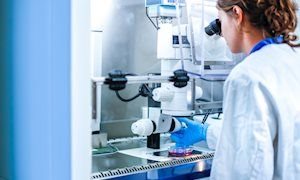
The Board of NWO Domain Science has awarded in the NWO Open Competition Domain Science, Jenny van der Wijst, theme Renal Disorders, the ENW KLEIN grant of 350,000 Euro. KLEIN grants offer researchers the possibility to realize curiosity-driven, fundamental research and elaborate creative and risky ideas.
The project “Calmodulation of the epithelial calcium channels TRPV5 and TRPV6: Untangle a dual-faced mechanism” is centered on how the calcium binding protein calmodulin conditions the ion channels’ physiology by exploiting our recently obtained structural data of the TRPV5-calmodulin complex. The TRPV5 and TRPV6 channels form a specific category within the large TRP family of ion channels as they are selectively permeable for calcium ions and play important roles in systemic calcium homeostasis. Using a combination of electrophysiology and advanced fluorescence microscopy, we aim to decipher the calcium-dependency of the TRPV5/6-calmodulin interaction and connect this to changes in channel activity, to provide a so-called ‘calmodulation’ model for these calcium-selective TRP channels.
Outcomes of this project will advance our understanding of the molecular machinery controlling calcium homeostasis. Moreover, it may open up studies for other TRP family members, which is highly relevant to move towards the complete comprehension of TRP channel (patho)physiology.
Related news items

Grants for heart and kidney research Two awards to Radboudumc in Open Competition ENW-XS
21 July 2022Two researchers from the Radboudumc receive a grant from the NWO within the Open Competition of the Exact and Natural Sciences. They are Thijs Eijsvogels, who studies the heart, and Pieter Leermakers, who studies the kidneys.
go to page
Grants for research on magnesium deficiency and malaria Vidis for Felix Hol and Jeroen de Baaij
1 July 2022 Radboudumc researchers Jeroen de Baaij and Felix Hol both receive an NWO Vidi grant for their research, respectively on magnesium deficiency in type 2 diabetes and on malaria. go to page
Innovation Grant Dutch Kidney Foundation for Jeroen de Baaij
23 May 2019 Jeroen de Baaij, theme Renal disorders, was awarded with an Innovation Grant of the Dutch Kidney Foundation. Jeroen's research proposal was selected from a competitive field of innovative approaches to treat kidney disease. go to page
RIMLS awards festival Twelve winners
16 January 2019 In 5 categories RIMLS young researchers received an award and bonus during the New Year's drinks. See all photo's. go to page
Junior Kolff Fellowship for Jeroen de Baaij
29 January 2018 Jeroen's research proposal ‘HNF1β: master regulator of cilia formation and electrolyte homeostasis in ADTKD-HNF1β patients’ was awarded a Junior Kolff Fellowships of € 225.000. go to page
